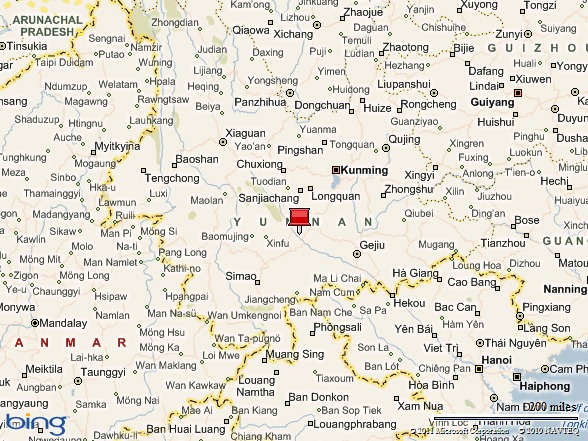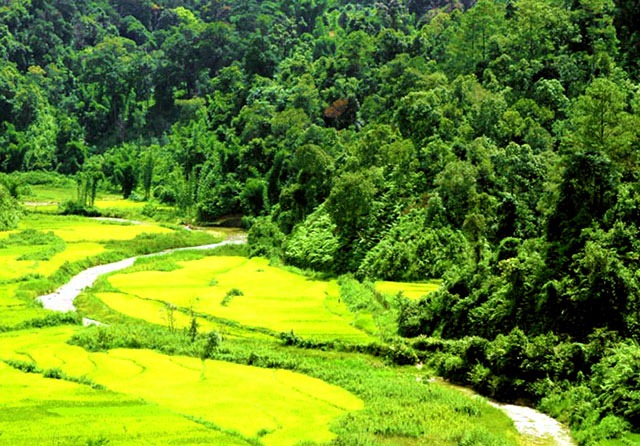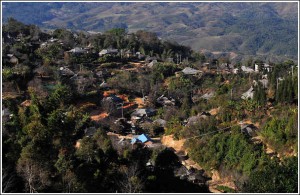
Yunnan
Yunnan province produces the vast majority of pu-erh tea. Indeed, the province is the source of the tea's name, Pu'er Hani and Yi Autonomous County. Pu-erh is produced in almost every county and prefecture in the province, but the most famous pu-erh areas are known as the Six Famous Tea Mountains (Chinese: 六大茶山; pinyin: liù dà chá shān)
Six famous tea mountains

The six famous tea mountains are a group of mountains in Xishuangbanna that are renowned for their climates and environments, which not only provide excellent growing conditions for pu-erh, but also produce unique taste profiles (akin to terroir in wine) in the produced pu-erh tea. Over the course of history, the designated mountains for the tea mountains have either been changed or listed differently.
In the Qing dynasty government records for pu-erh (普洱府志), the oldest historically designated mountains were said to be named after six commemorative items that were left in the mountains by Zhuge Liang, and using the Chinese characters of the native language of the region. These mountains are all located northeast of the Lancang River (Mekong) in relatively close proximity to one another.
The mountain's names,in the Standard Mandarin character pronunciation are:
1.Gedeng(革登山):The term for "leather stirrup"·
2.Mansa(慢撤业):The term for"seed sowing bag"
3.Mangzhi(莽枝山):The term for"copper cauldron"
4.Manzhuan(蠻磚山):The term for“iron brick”
5.Yibang(倚邦山):The term for"wooden clapper"
6. Youle(攸樂山):The term meaning “copper gong”
South west of the river there are also six famous tea mountains that are lesser known from ancient times due to their isolation by the river. They are:
1·Mengsong Shan(勐宋山):
2·Menghai Shan(勐海山):
3·Jingmai Shan(景迈山):
4.Nannuo Shan(南糯山):a varietal of tea grows here called Zi Juan(紫鹃,Literally "purple Iady")whose buds and bud leaves have a purple hue.
5·Bada Shan(巴达山):
6.Youle(攸乐山):
For various reasons,by the end of the Qing dynasty or beginning of the ROC period,tea
Production In these mountains dropped drastically,either due to large forest fires,over- harvesting,prohibitive imperial taxes,or general neglect.To revitalize tea
Production in the area,the Chinese government in 1962 selected a new group of six famous tea mountains that were named based on the more important tea producing Mountains at the time,including Youle mountain from the original six.
 Other areas of Yunnan
Other areas of Yunnan
Many other areas of Yunnan also produce Pu-er tea.Yunnan prefectures that are major producers of Pu-erh include Lincang, Dehong, Simao, Xishuangbanna, and Wenshan·
Other tea mountains famous in Yunnan include among others:
Bangwei Shan(邦葳山)
Banzhang(班章):a Hani ethnicity village in the Bulang Mountains,noted for producing
Powerful and complex teas that are bitter with a sweet after taste
Yiwu Shan(易武山): perhaps the most popular tea mountain amongst Collectors.
Bada Shan(八達山):
Wuliang Shan (无量山):
Ailuo shan:
Jinggu Shan:
Baoshan:
Yushou Shan:
Region is but one factor in assessing a Pu-erh tea,and Pu-erh tea from any region of Yunnan is as prlzed as any from the six famous tea mountains if it meets other criteria,such as being wild growth,hand一processed tea.
Other provinces
While Yunnan produces the majority of pu-erh, other regions of China, including Hunan and Guangdong, have also produced the tea. The Guangyun Gong cake, for example, featured a blend of Yunnan and Guangdong máochá, and the most recent production of these cakes contains mostly from the latter.
In late 2008, the Chinese government approved a standard declaring Puer tea as a "product with geographical indications", which would restrict the naming of tea as Puer to tea produced within specific regions of the Yunnan province. The standard has been disputed, particularly by producers from Guangdong.
Other regions
In addition to China, border regions touching Yunnan in Vietnam, Laos, and Burma are also known to produce pu-erh tea, though little of this makes its way to the Chinese or international markets.


Hey there, You have done an incredible job. I will certainly digg it and personally recommend to my friends. I'm confident they'll be benefited from this web site.
Very well written information. It will be beneficial to everyone who usess it, including me. Keep doing what you are doing - can'r wait to read more posts.
A person essentially help to make seriously articles I would state. This is the very first time I frequented your website page and thus far? I surprised with the research you made to create this particular publish amazing. Fantastic job!
I've been absent for some time, but now I remember why I used to love this site. Thanks , I will try and check back more often. How frequently you update your web site?
I do agree with all of the ideas you've presented in your post. They are very convincing and will certainly work. Still, the posts are too short for starters. Could you please extend them a little from next time? Thanks for the post.
Hey very nice web site!! Man .. Beautiful .. Amazing .. I will bookmark your web site and take the feeds also…I am happy to find so many useful information here in the post, we need work out more techniques in this regard, thanks for sharing. . . . . .
Hey there! I just wanted to ask if you ever have any trouble with hackers? My last blog (wordpress) was hacked and I ended up losing several weeks of hard work due to no back up. Do you have any methods to protect against hackers?
Superb blog! Do you have any tips for aspiring writers? I'm hoping to start my own website soon but I'm a little lost on everything. Would you suggest starting with a free platform like Wordpress or go for a paid option? There are so many options out there that I'm completely overwhelmed .. Any recommendations? Thanks a lot!
Unquestionably believe that which you stated. Your favourite justification seemed to be at the web the easiest thing to take into accout of. I say to you, I definitely get irked at the same time as folks think about concerns that they just don't recognise about. You managed to hit the nail upon the top and defined out the entire thing without having side effect , folks could take a signal. Will probably be again to get more. Thanks
great post, very informative. I wonder why the other experts of this sector don't notice this. You must continue your writing. I am confident, you have a huge readers' base already!